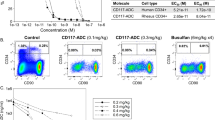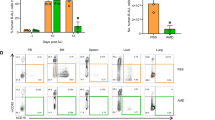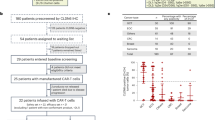Abstract
Chemotherapy with 1,3-bis (2-chloroethyl)-1-nitrosourea (BCNU) and temozolomide (TMZ) is commonly used for the treatment of glioblastoma multiforme (GBM) and other cancers. In preparation for a clinical gene therapy study in patients with glioblastoma, we wished to study whether these reagents could be used as a reduced-intensity conditioning regimen for autologous transplantation of gene-modified cells. We used an MGMT(P140K)-expressing lentivirus vector to modify dog CD34+ cells and tested in four dogs whether these autologous cells engraft and provide chemoprotection after transplantation. Treatment with O6-benzylguanine (O6BG)/TMZ after transplantation resulted in gene marking levels up to 75%, without significant hematopoietic cytopenia, which is consistent with hematopoietic chemoprotection. Retrovirus integration analysis showed that multiple clones contribute to hematopoiesis. These studies demonstrate the ability to achieve stable engraftment of MGMT(P140K)-modified autologous hematopoietic stem cells (HSCs) after a novel reduced-intensity conditioning protocol using a combination of BCNU and TMZ. Furthermore, we show that MGMT(P140K)-HSC engraftment provides chemoprotection during TMZ dose escalation. Clinically, chemoconditioning with BCNU and TMZ should facilitate engraftment of MGMT(P140K)-modified cells while providing antitumor activity for patients with poor prognosis glioblastoma or alkylating agent-sensitive tumors, thereby supporting dose-intensified chemotherapy regimens.
This is a preview of subscription content, access via your institution
Access options
Subscribe to this journal
Receive 12 print issues and online access
$259.00 per year
only $21.58 per issue
Buy this article
- Purchase on Springer Link
- Instant access to full article PDF
Prices may be subject to local taxes which are calculated during checkout


Similar content being viewed by others
References
Neff T, Beard BC, Kiem H-P . Survival of the fittest: in vivo selection and stem cell gene therapy (Review). Blood 2006; 107: 1751–1760.
Beard BC, Trobridge GD, Ironside C, McCune JS, Adair JE, Kiem H-P . Efficient and stable MGMT-mediated selection of long-term repopulating stem cells in nonhuman primates. J Clin Invest 2010; 120: 2345–2354.
Beard BC, Sud R, Keyser KA, Ironside C, Neff T, Gerull S et al. Long-term polyclonal and multilineage engraftment of methylguanine methyltransferase P140K gene-modified dog hematopoietic cells in primary and secondary recipients. Blood 2009; 113: 5094–5103.
Cartier N, Hacein-Bey-Abina S, Bartholomae CC, Veres G, Schmidt M, Kutschera I et al. Hematopoietic stem cell gene therapy with a lentiviral vector in X-linked adrenoleukodystrophy. Science 2009; 326: 818–823.
Aiuti A, Cassani B, Andolfi G, Mirolo M, Biasco L, Recchia A et al. Multilineage hematopoietic reconstitution without clonal selection in ADA-SCID patients treated with stem cell gene therapy. J Clin Invest 2007; 117: 2233–2240.
Ott MG, Schmidt M, Schwarzwaelder K, Stein S, Siler U, Koehl U et al. Correction of X-linked chronic granulomatous disease by gene therapy, augmented by insertional activation of MDS1-EVI1, PRDM16 or SETBP1. Nat Med 2006; 12: 401–409.
Hacein-Bey-Abina S, Le Deist F, Carlier F, Bouneaud C, Hue C, De Villartay JP et al. Sustained correction of X-linked severe combined immunodeficiency by ex vivo gene therapy. N Engl J Med 2002; 346: 1185–1193.
Andion M, Molina B, Gonzalez-Vicent M, Alonso L, Hernandez C, Lassaletta A et al. High-dose busulfan and cyclophosphamide as a conditioning regimen for autologous peripheral blood stem cell transplantation in childhood non-Hodgkin lymphoma patients: a long-term follow-up study. J Pediatr Hematol Oncol 2011; 33: e89–e91.
Gozdzik J, Pituch-Noworolska A, Skoczen S, Czogala W, Baran J, Krasowska-Kwiecien A et al. Allogeneic haematopoietic stem cell transplantation as therapy for chronic granulomatous disease-single centre experience. J Clin Immunol 2011; 31: 332–337.
Escalon MP, Stefanovic A, Venkatraman A, Pereira D, Santos ES, Goodman M et al. Autologous transplantation for relapsed non-Hodgkin's lymphoma using intravenous busulfan and cyclophosphamide as conditioning regimen: a single center experience. Bone Marrow Transplant 2009; 44: 89–96.
McCune JS, Batchelder A, Deeg HJ, Gooley T, Cole S, Phillips B et al. Cyclophosphamide following targeted oral busulfan as conditioning for hematopoietic cell transplantation: pharmacokinetics, liver toxicity, and mortality. Biol Blood Marrow Transplant 2007; 13: 853–862.
Gerull S, Beard BC, Peterson LJ, Neff T, Kiem H-P . In vivo selection and chemoprotection after drug resistance gene therapy in a nonmyeloablative allogeneic transplantation setting in dogs. Hum Gene Ther 2007; 18: 451–456.
Cancrini C, Ferrua F, Scarselli A, Brigida I, Romiti ML, Barera G et al. Role of reduced intensity conditioning in T-cell and B-cell immune reconstitution after HLA-identical bone marrow transplantation in ADA-SCID. Haematologica 2010; 95: 1778–1782.
Bashey A, Owzar K, Johnson JL, Edwards PS, Kelly M, Baxter-Lowe LA et al. Reduced-intensity conditioning allogeneic hematopoietic cell transplantation for patients with hematologic malignancies who relapse following autologous transplantation: a multi-institutional prospective study from the Cancer and Leukemia Group B (CALGB trial 100002). Biol Blood Marrow Transplant 2011; 17: 558–565.
Shea T, Johnson J, Westervelt P, Farag S, McCarty J, Bashey A et al. Reduced-intensity allogeneic transplantation provides high event-free and overall survival in patients with advanced indolent B cell malignancies: CALGB 109901. Biol Blood Marrow Transplant 2011; 17: 1395–1403.
Ho AYL, Pagliuca A, Kenyon M, Parker JE, Mijovic A, Devereux S et al. Reduced-intensity allogeneic hematopoietic stem cell transplantation for myelodysplastic syndrome and acute myeloid leukemia with multilineage dysplasia using fludarabine, busulphan and alemtuzumab (FBC) conditioning. Blood 2004; 104: 1616–1623.
Quinn JA, Pluda J, Dolan ME, Delaney S, Kaplan R, Rich JN et al. Phase II trial of carmustine plus O(6)-benzylguanine for patients with nitrosourea-resistant recurrent or progressive malignant glioma. J Clin Oncol 2002; 20: 2277–2283.
Schold SCJ, Kuhn JG, Chang SM, Bosik ME, Robins HI, Mehta MP et al. A phase I trial of 1,3-bis(2-chloroethyl)-1-nitrosourea plus temozolomide: a North American Brain Tumor Consortium study [published erratum appears in Neuro-oncology 2001; 3:123]. Neuro-oncology 2000; 2: 34–39.
Vinjamuri M, Adumala RR, Altaha R, Hobbs GR, Crowell Jr EB . Comparative analysis of temozolomide (TMZ) versus 1,3-bis (2-chloroethyl)-1 nitrosourea (BCNU) in newly diagnosed glioblastoma multiforme (GBM) patients. J Neurooncol 2009; 91: 221–225.
Nishikawa R . Standard therapy for glioblastoma--a review of where we are. Neurol Med Chir 2010; 50: 713–719.
Nieder C, Grosu AL, Molls M . A comparison of treatment results for recurrent malignant gliomas (Review). Cancer Treat Rev 2000; 26: 397–409.
McGirt MJ, Than KD, Weingart JD, Chaichana KL, Attenello FJ, Olivi A et al. Gliadel (BCNU) wafer plus concomitant temozolomide therapy after primary resection of glioblastoma multiforme. J Neurosurg 2009; 110: 583–588.
Barrie M, Couprie C, Dufour H, Figarella-Branger D, Muracciole X, Hoang-Xuan K et al. Temozolomide in combination with BCNU before and after radiotherapy in patients with inoperable newly diagnosed glioblastoma multiforme. Ann Oncol 2005; 16: 1177–1184.
Chang SM, Butowski NA, Sneed PK, Garner IV . Standard treatment and experimental targeted drug therapy for recurrent glioblastoma multiforme (Review). Neurosurg Focus 2006; 20: E4.
Chang SM, Prados MD, Yung WK, Fine H, Junck L, Greenberg H et al. Phase II study of neoadjuvant 1, 3-bis (2-chloroethyl)-1-nitrosourea and temozolomide for newly diagnosed anaplastic glioma: a North American Brain Tumor Consortium Trial. Cancer 2004; 100: 1712–1716.
Chinnasamy N, Rafferty JA, Hickson I, Ashby J, Tinwell H, Margison GP et al. O6-benzylguanine potentiates the in vivo toxicity and clastogenicity of temozolomide and BCNU in mouse bone marrow. Blood 1997; 89: 1566–1573.
Westerhof GR, Down JD, Blokland I, Wood M, Boudewijn A, Watson AJ et al. O6-Benzylguanine potentiates BCNU but not busulfan toxicity in hematopoietic stem cells. Exp Hematol 2001; 29: 633–638.
Friedman HS, Keir S, Pegg AE, Houghton PJ, Colvin OM, Moschel RC et al. O6-benzylguanine-mediated enhancement of chemotherapy. Mol Cancer Ther 2002; 1: 943–948.
Neff T, Horn PA, Peterson LJ, Thomasson BM, Thompson J, Williams DA et al. Methylguanine methyltransferase-mediated in vivo selection and chemoprotection of allogeneic stem cells in a large-animal model. J Clin Invest 2003; 112: 1581–1588.
Neff T, Beard BC, Peterson LJ, Anandakumar P, Thompson J, Kiem H-P . Polyclonal chemoprotection against temozolomide in a large-animal model of drug resistance gene therapy. Blood 2005; 105: 997–1002.
Horn PA, Keyser KA, Peterson LJ, Neff T, Thomasson BM, Thompson J et al. Efficient lentiviral gene transfer to canine repopulating cells using an overnight transduction protocol. Blood 2004; 103: 3710–3716.
Goerner M, Horn PA, Peterson L, Kurre P, Storb R, Rasko JEJ et al. Sustained multilineage gene persistence and expression in dogs transplanted with CD34+ marrow cells transduced by RD114-pseudotype oncoretrovirus vectors. Blood 2001; 98: 2065–2070.
Neff T, Horn PA, Valli VE, Gown AM, Wardwell S, Wood BL et al. Pharmacologically regulated in vivo selection in a large animal. Blood 2002; 100: 2026–2031.
Fischer A, Hacein-Bey-Abina S, Cavazzana-Calvo M . Gene therapy for primary adaptive immune deficiencies. J Allergy Clin Immunol 2011; 127: 1356–1359.
Aiuti A, Slavin S, Aker M, Ficara F, Deola S, Mortellaro A et al. Correction of ADA-SCID by stem cell gene therapy combined with nonmyeloablative conditioning. Science 2002; 296: 2410–2413.
Boztug K, Schmidt M, Schwarzer A, Banerjee PP, Avedillo I, Dewey RA et al. Stem-cell gene therapy for the Wiskott-Aldrich syndrome. N Engl J Med 2010; 363: 1918–1927.
Rattmann I, Kleff V, Sorg UR, Bardenheuer W, Brueckner A, Hilger RA et al. Gene transfer of cytidine deaminase protects myelopoiesis from cytidine analogs in an in vivo murine transplant model. Blood 2006; 108: 2965–2971.
Budak-Alpdogan T, Alpdogan O, Banerjee D, Wang E, Moore MA, Bertino JR . Methotrexate and cytarabine inhibit progression of human lymphoma in NOD/SCID mice carrying a mutant dihydrofolate reductase and cytidine deaminase fusion gene. Mol Ther 2004; 10: 574–584.
de Cremoux P, Jourdan-Da-Silva N, Couturier J, Tran-Perennou C, Schleiermacher G, Fehlbaum P et al. Role of chemotherapy resistance genes in outcome of neuroblastoma. Pediatr Blood Cancer 2007; 48: 311–317.
Martin LP, Schilder RJ . Management of recurrent ovarian carcinoma: current status and future directions (Review). Semin Oncol 2009; 36: 112–125.
Stewart DJ . Tumor and host factors that may limit efficacy of chemotherapy in non-small cell and small cell lung cancer (Review). Crit Rev Oncol Hematol 2010; 75: 173–234.
Noguchi S . Predictive factors for response to docetaxel in human breast cancers (Review). Cancer Sci 2006; 97: 813–820.
McGrogan BT, Gilmartin B, Carney DN, McCann A . Taxanes, microtubules and chemoresistant breast cancer (Review). Biochim Biophys Acta 2008; 1785: 96–132.
Acknowledgements
We thank Helen Crawford, Laura Farren and Bonnie Larson for help in preparing this manuscript. We also thank Michele Spector and the Fred Hutchinson Cancer Research Center Dog Lab staff for the care of the dogs. This work was supported in part by National Institutes of Health (Bethesda, MD) grants P01HL036444, R01HL074162 and P30DK056465. H-PK is a Markey Molecular Medicine Investigator and the recipient of the José Carreras/ED Thomas Endowed Chair for Cancer Research. The content is solely the responsibility of the authors and does not necessarily represent the official views of the National Institutes of Health nor its subsidiary Institutes and Centers.
Author information
Authors and Affiliations
Corresponding author
Ethics declarations
Competing interests
The authors declare no conflict of interest.
Additional information
Supplementary Information accompanies the paper on Cancer Gene Therapy website
Supplementary information
Rights and permissions
About this article
Cite this article
Gori, J., Beard, B., Ironside, C. et al. In vivo selection of autologous MGMT gene-modified cells following reduced-intensity conditioning with BCNU and temozolomide in the dog model. Cancer Gene Ther 19, 523–529 (2012). https://doi.org/10.1038/cgt.2012.25
Received:
Revised:
Accepted:
Published:
Issue Date:
DOI: https://doi.org/10.1038/cgt.2012.25



